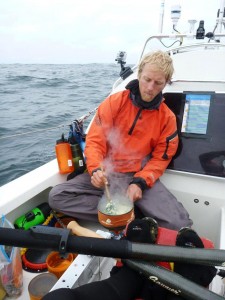
We have been getting lots of questions via direct message and from people on the street during layovers about the average day on an ocean rowboat. I thought I’d take a moment to paint that picture, and see if we have any aspiring adventurers out there.
Sleep/Wake Cycle: Traditional cycles are row 2 hours, rest 2 hours. During your rest time it’s up to you whether you sleep, brush your teeth, eat, do laundry, etc. For this trip, Adam researched polyphasic sleep cycles and created a regimen that has us rowing 1, 2, or 4 hours at a stretch. Among those are mandatory sleep times, others are free. 4 hours is a long time to row, but it’s a GREAT time to catch up on the Zzzzz.
Eating/Drinking: Hydration is key when you’re rowing up to 12 hours per day, per person, on a 24 hour schedule. We make fresh water a couple times per week through the desalinator or “water maker.” My sister Angie researched optimum meal planning for this type of adventure, and together with Adam and all the healthy goodness provided courtesy of Victoria’s Lifestyles Markets, we feast daily on assorted oats, grains, meats, supplements in various forms. In addition, we eat SPAM (I know, right?), granola, and the most important, a good Snickers candy bar now and then. We cook most meals in Jetboil stoves, which are real handy as the burner is affixed directly to the insulated cup. In a Jetboil things cook real quick so we can get to bed.
Hygiene: When it’s sleepy-time, it’s easy to let things go when all you want to do is crawl in bed for your off-shift. But it’s important to take the time to brush your teeth, and we thank Cathy Tarbill for our tooth care products! Additionally, one often washes hands and puts on plenty of Sol Sunguard sunscreen so we don’t get burnt. When possible, we try to let the nooks and crannies get some fresh air.
Safety, day & night: Our boat moves pretty sluggishly. However, if one falls out of the boat it’s “flying” along at 3-4 knots on a downwind leg, chances are slim that the boat and crew will be able to make it back around and upwind to pick you up. Everybody on-deck wears an inflatable Mustang Survival lifejacket courtesy of Mustang Survival. These would automatically inflate upon immersion. We’re also tethered to a safety line that runs the length of the deck. The line is long enough so in the event of a capsize, the line will take a full wrap around the boat and hopefully preventing one from being trapped under water. Additionally, we have PLB’s (Personal Locator Beacons) attached to every lifejacket in case of separation. Also onboard is a life raft that can hold four rowers, in case we need to abandon ship.
Navigation: Paper charts, computer charts, GPS, compass, and visual observation. On this trip, coastal hazards abound, and with the addition of currents that will put you where they want you (like, you know, on big hard rocks), we have to be focused. The University of Washington’s student chapter of the American Meteorological Society is providing twice daily forecasting for wind and weather conditions. These forecasts become increasingly important as we near the Strait of Juan de Fuca.
Please keep sending your questions and comments via the “Message the Crew” link on the front page, or leave a comment here!
